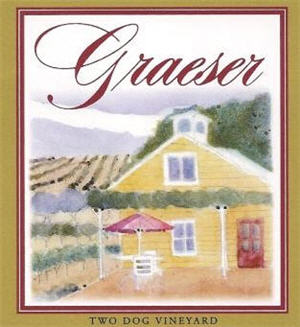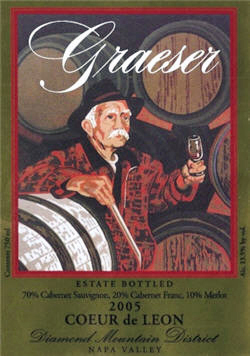

Everything old is new again.
Diamond Mountain District ~ Napa Valley (AVA)
What’s Good For Graeser
Should Be Good For The Country
by
Alan Goldfarb
June 15, 2009
Some might think Richard Graeser an anachronism when considering:
He once grew Iceberg lettuce, the kind that your grandmother used;
He lives on Petrified Forest Road;
He’s 76 years old;
He says of his winery, whose buildings, from the 1880s, are hardly touched save for an occasional paint job: “it’s an oasis of old Napa Valley charm”;
There he is, on his business card, a cartoon character looking like Geppetto with wine glass, replete with big, droopy white moustache;
And he makes wines that some might think are of another time.
To which he says about himself and his wines, “I’m probably a little iconoclastic, (but) would it be an anachronism? No, I think it’s the way wine should be; and it will come back to that style. It’s not for being put on a pedestal and for be revering about; if that’s anachronistic, than I’m anachronistic.”

Richard GraeserThere are but a handful or two of California winemakers like Richard Graeser, folks who deliberately set out to make wines in an Old World style. That is, wines that are not sweet and full of jam; wines that are in-balance and have an affinity with food. But one has to look really hard to find those wines.
In Napa, there are the Smith brothers at Smith-Madrone, or Kathy Corison at Corison Winery, Richard Dunn at Dunn Vineyards and John Williams at Frog’s Leap Winery, to name a few. And then there’s Richard Graeser, who’s up on Diamond Mountain on the northwest side of the Napa Valley, and his 9½-acre vineyard that slopes so severely that he says of it, “It’s terrible steep. You fall down, and you roll.”
It’s a 40 percent grade that doesn’t hold much water and perhaps it's this slanted aspect of the vineyard at Graeser Winery which allows Graeser to pragmatically make wines that are lower in alcohol than many other wines from Napa Valley. He picks at about 23.5 percent sugar levels instead of upwards of 26° Brix. Philosophically, however, Graeser (pronounced GRAY zhur) is drawn to that style of wine.
“It is the sine qua non of winemaking and it’s the way that wine should be made; and not necessarily be made for selling at wine bar,” he explains, as if everyone knew that, adding, “and because it’s my style and I’m just a stubborn old coot and like to do things my way.”
 His way is to make about 1,000-2,000 cases a year of Cabernet Sauvignon, Cabernet Franc, and a blend he calls Coeur De Leon that sells from $50-60, and hold them back a year or two longer than most. After tasting a trio of the wines recently, I characterize them as possessing deep, layered flavors. Even more interesting is that they are not showy; just good, solid, well-made wines that will age for a long while. Kind of like Richard Graeser himself.
His way is to make about 1,000-2,000 cases a year of Cabernet Sauvignon, Cabernet Franc, and a blend he calls Coeur De Leon that sells from $50-60, and hold them back a year or two longer than most. After tasting a trio of the wines recently, I characterize them as possessing deep, layered flavors. Even more interesting is that they are not showy; just good, solid, well-made wines that will age for a long while. Kind of like Richard Graeser himself.
“I can go another 10 years if I could,” says the man, who insists he didn’t know a thing about farming when he began growing lettuce in California’s Imperial Valley, from where he became a millionaire before the age of 40; and that he didn’t know a thing about winemaking when he released his first bottle in 1987. “I’ll just go on, probably like (Mike) Grgich (Grgich Hills winery). I don’t want to retire.”
Compared to lettuce though, wine seems to fit perfectly into Graeser’s lifestyle. He says of Iceberg, “It was very much of a commodity. There wasn’t much of a brand identity … Wine is a lot more personal. People identify with your vineyard and your style, (and) I have a different style than most.”
Of that style he says it is, “More traditional, European, with lower alcohol (all under 14 percent), and lower extraction. I’m trying to make a food-friendly wine. Many wines made now overwhelm the food and you want to stop drinking.”
When he’s asked the loaded question - “Why aren’t most California wines made that way? - he answers, “It’s the herd thing …and they all (his colleagues) fell in line. Winemakers get together a lot, but I don’t hang out with them. I guess I just don’t speak their language. Besides, I spend most of my time working here and I don’t get much time to get out.”
Nonetheless, he believes his style will make a comeback. “It seems to me it’s the right thing to do (make this style),” he surmises. “People like it, if they’re given the opportunity. … Many people who don’t know any better, and believe that if (über-critic) Robert Parker writes about a wine, it’s got to be good; and if they don’t recognize it, they think there’s something wrong with them, and then wonder what kind of person they are.”
Evidently iconoclastic, anachronistic Richard Graeser suffers no such illusions. He knows precisely what type of person he is; and by extension, he is fully aware of the kind of wines he wants to make and drink.![graeser-[th].jpg](http://wine.appellationamerica.com/images/appellations/features/graeser-[th].jpg) To which he concludes by conflating an old saying that’s an amalgam of the old Progressive Party formed by Teddy Roosevelt and that of Al Capp’s character General Bullmoose: “What’s good for Bull Moose, is good for the country.”
To which he concludes by conflating an old saying that’s an amalgam of the old Progressive Party formed by Teddy Roosevelt and that of Al Capp’s character General Bullmoose: “What’s good for Bull Moose, is good for the country.”
But what doesn’t hold any longer for General Motors and the General is apparently still true for Richard Graeser.
He once grew Iceberg lettuce, the kind that your grandmother used;
He lives on Petrified Forest Road;
He’s 76 years old;
He says of his winery, whose buildings, from the 1880s, are hardly touched save for an occasional paint job: “it’s an oasis of old Napa Valley charm”;
There he is, on his business card, a cartoon character looking like Geppetto with wine glass, replete with big, droopy white moustache;
And he makes wines that some might think are of another time.
To which he says about himself and his wines, “I’m probably a little iconoclastic, (but) would it be an anachronism? No, I think it’s the way wine should be; and it will come back to that style. It’s not for being put on a pedestal and for be revering about; if that’s anachronistic, than I’m anachronistic.”

Richard Graeser
In Napa, there are the Smith brothers at Smith-Madrone, or Kathy Corison at Corison Winery, Richard Dunn at Dunn Vineyards and John Williams at Frog’s Leap Winery, to name a few. And then there’s Richard Graeser, who’s up on Diamond Mountain on the northwest side of the Napa Valley, and his 9½-acre vineyard that slopes so severely that he says of it, “It’s terrible steep. You fall down, and you roll.”
It’s a 40 percent grade that doesn’t hold much water and perhaps it's this slanted aspect of the vineyard at Graeser Winery which allows Graeser to pragmatically make wines that are lower in alcohol than many other wines from Napa Valley. He picks at about 23.5 percent sugar levels instead of upwards of 26° Brix. Philosophically, however, Graeser (pronounced GRAY zhur) is drawn to that style of wine.
“It is the sine qua non of winemaking and it’s the way that wine should be made; and not necessarily be made for selling at wine bar,” he explains, as if everyone knew that, adding, “and because it’s my style and I’m just a stubborn old coot and like to do things my way.”
 His way is to make about 1,000-2,000 cases a year of Cabernet Sauvignon, Cabernet Franc, and a blend he calls Coeur De Leon that sells from $50-60, and hold them back a year or two longer than most. After tasting a trio of the wines recently, I characterize them as possessing deep, layered flavors. Even more interesting is that they are not showy; just good, solid, well-made wines that will age for a long while. Kind of like Richard Graeser himself.
His way is to make about 1,000-2,000 cases a year of Cabernet Sauvignon, Cabernet Franc, and a blend he calls Coeur De Leon that sells from $50-60, and hold them back a year or two longer than most. After tasting a trio of the wines recently, I characterize them as possessing deep, layered flavors. Even more interesting is that they are not showy; just good, solid, well-made wines that will age for a long while. Kind of like Richard Graeser himself.
“I can go another 10 years if I could,” says the man, who insists he didn’t know a thing about farming when he began growing lettuce in California’s Imperial Valley, from where he became a millionaire before the age of 40; and that he didn’t know a thing about winemaking when he released his first bottle in 1987. “I’ll just go on, probably like (Mike) Grgich (Grgich Hills winery). I don’t want to retire.”
Compared to lettuce though, wine seems to fit perfectly into Graeser’s lifestyle. He says of Iceberg, “It was very much of a commodity. There wasn’t much of a brand identity … Wine is a lot more personal. People identify with your vineyard and your style, (and) I have a different style than most.”
Of that style he says it is, “More traditional, European, with lower alcohol (all under 14 percent), and lower extraction. I’m trying to make a food-friendly wine. Many wines made now overwhelm the food and you want to stop drinking.”
When he’s asked the loaded question - “Why aren’t most California wines made that way? - he answers, “It’s the herd thing …and they all (his colleagues) fell in line. Winemakers get together a lot, but I don’t hang out with them. I guess I just don’t speak their language. Besides, I spend most of my time working here and I don’t get much time to get out.”
Nonetheless, he believes his style will make a comeback. “It seems to me it’s the right thing to do (make this style),” he surmises. “People like it, if they’re given the opportunity. … Many people who don’t know any better, and believe that if (über-critic) Robert Parker writes about a wine, it’s got to be good; and if they don’t recognize it, they think there’s something wrong with them, and then wonder what kind of person they are.”
Evidently iconoclastic, anachronistic Richard Graeser suffers no such illusions. He knows precisely what type of person he is; and by extension, he is fully aware of the kind of wines he wants to make and drink.
![graeser-[th].jpg](http://wine.appellationamerica.com/images/appellations/features/graeser-[th].jpg) To which he concludes by conflating an old saying that’s an amalgam of the old Progressive Party formed by Teddy Roosevelt and that of Al Capp’s character General Bullmoose: “What’s good for Bull Moose, is good for the country.”
To which he concludes by conflating an old saying that’s an amalgam of the old Progressive Party formed by Teddy Roosevelt and that of Al Capp’s character General Bullmoose: “What’s good for Bull Moose, is good for the country.”
But what doesn’t hold any longer for General Motors and the General is apparently still true for Richard Graeser.










 READER FEEDBACK: To post your comments on this story,
READER FEEDBACK: To post your comments on this story,



